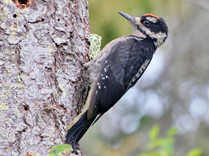Have you been practicing your bird identification skills from last week? I hope you were able to identify one new bird outside. If you missed it last week’s Raptors & Vultures post, click here. This week, we will be learning about “Woodpeckers”. These birds can be seen in the woods, near burned forests, in pine trees, oak trees, groves, swamps, or in snags. Get outside and practice your bird identification skills!
Bird watching is an activity that is ageless – anyone can learn and appreciate the wonderous bird species. All you need are a pair of binoculars. Let us know if you can spot and identify one of these Woodpeckers this week!
Hairy Woodpecker
Habitat:
- Mature forest across the continent
- Woodlots, suburbs, parks, cemeteries, forest edges, open woodlands of oak and pine, recently burned forests, and stands infested by bark beetles
Diet:
- Hitch up tree trunks and along main branches
- Feed at the bases of trees, along fallen logs, and even on the ground
- 75% of their diet is insects
- Wood-boring beetles and their larvae, caterpillars, millipedes, cockroaches, ants, grasshoppers, beetles, flies, and spiders
Nesting:
- Nest site is cavity (excavated by both sexes), mainly in deciduous trees in east, in aspens or dead conifers in west
- Clutch size: 4 eggs (white)
Click here for more information.
Downy Woodpecker
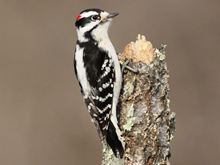
Habitat:
- Open woodlands and brushy or weedy edges, and orchards, city parks, backyards and vacant lots
Diet:
- Beetles, weevils, ants, bugs, plant lice, and caterpillars, scale insects and spiders
Nesting:
- Nest site is cavity (excavated by both sexes) in dead limb or dead tree
- Cavity entrance is often surrounded by fungus or lichen, helping to camouflage site
- Clutch size: 4-5 eggs (white)
*Note: Very common and widespread, with no evidence of population declines.
Click here for more information.
Red-Bellied Woodpecker
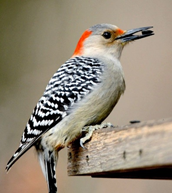
Habitat:
- Pine scrub, hardwood swamps, cypress swamps, hammocks, mixed woods, pine flatwoods, sandhills, and agriculture areas
- Thrives in every habitat where there are trees (including urban and suburban areas) and is not all particular in its choice of nest tree
- Cavities in pine, cypress, palm, hardwood, or nest boxes
Diet:
- Insects, seeds, mast, fruit, and pulp
- Plant material:
- Spring: 44%
- Fall & Winter: >80%
Nesting:
- Cavities from 5 to 70 ft. above the ground
- Clutch size: 4-5 eggs (white)
*Note: Often more than 1 cavity exists in a suitable tree, but seldom is there more than 1 pair of birds per tree. The adults may roost in the nest cavity an use the same cavity for nesting in successive years.
Click here for more information.
Red-Headed Woodpecker
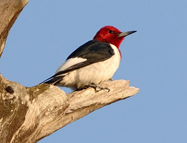
Habitat:
- Groves, farm country, orchards, shade trees in towns, large scattered trees
- Forest edges, orchards, open pine woods, grove of tall trees
Diet:
- Spring & Summer: 66% animal matter
- Fall & Winter: <25% animal matter
- Fruits, berries, nuts, corn, and other grains
- “Hawking” for insects from a favored perch and catching them in flight or landing on roadways to pick up insects
- Killed by automobiles
Nesting:
- The nesting cavity is located from 5 to 80 ft. above the ground, usually in a bark less dead tree
- No nesting material is added to the cavity, but wood chips accumulate on the bottom
- Clutch size: 4-7 eggs (white)
- Fierce defenders of their territory (may remove other eggs from nests, destroy other nests)
*Note: The Red-Headed Woodpecker is one of the only four North American woodpeckers known to store food, and it is the only one known to cover the stored food with wood or bark. It hides insects and seeds in cracks in wood, under bark, in fenceposts, and under roof shingles.
Click here for more information.
Pileated Woodpecker
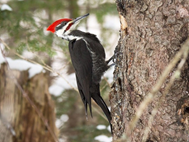
Habitat:
- Wide variety of mature forest types
- Conifer, mixed, and hardwood forests; woodlots
- Wide variety of specific forest types from southern swamps to old-growth Douglas-fir forest of northwest
Diet:
- Forages by probing, prying, and excavating in dead wood in search of insects
- Spring & Summer: >80% insects (carpenter ants in fallen trees and stumps)
- Fall & Winter: 50% fruits, nuts, and berries
Nesting:
- High in a dead tree or utility poles
- Clutch size: 3-5 eggs (white)
Click here for more information.
Be sure to tune in every week to learn more bird identifications!
Again, if you missed last week’s Raptors & Vultures blog post, click here.
 1
1
